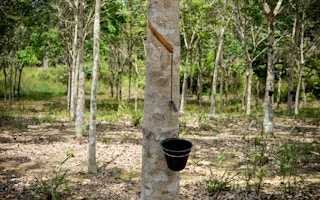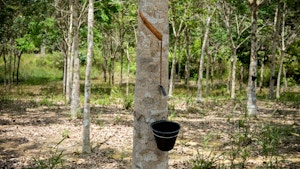Rubber is found in products as varied as car tyres, hoses, medical gloves and condoms, and pervades every aspect of modern life. But the squidgy stuff produced by the Hevea brasiliensis tree has a simple backstory.
Some 85 per cent of the natural rubber grown globally is produced by small, family-run enterprises in Asia whose plantations cover just a few hectares. This means that the sustainability of an industry linked to deforestation, pollution and human rights abuses lies in the hands of hundreds of thousands of individual farmers.
However, recent interviews conducted by the Global Platform for Sustainable Natural Rubber (GPSNR), a non-profit set up to ensure the sustainable production and supply of natural rubber, smallholders from some of the world’s top rubber producing countries, including Indonesia, Thailand and Vietnam, pointed to the many challenges preventing them from adopting more sustainable practices. To begin with, many smallholders do not know what sustainable natural rubber really means.
“There’s a need to define exactly what it is to be sustainable. What are the rules for being sustainable? What do I have to do to be sustainable?” asked Elizeu Santos, a smallholder in the state of Paraná in Brazil, one of the home countries of natural rubber. “Rubber producers can help the environment by implementing sustainability standards on their farms, but we need to know what they are first.”
“
It’s not right if you want to save the world but do not care about rubber farmers.
Prasert Jaranrittikul, rubber farmer, Thailand
Others shared that they are unlikely to be able to afford investments in sustainability, as rubber prices have remained low for the several years, leaving them struggling to make a living. Amiruddin Kasseng, a smallholder from Penajam Paser in East Kalimantan, Indonesia, said that banks should extend loans to smallholders to finance sustainability improvements.
Prasert Jaranrittikul, a smallholder rubber farmer in Thailand’s Trat province, added that rubber buyers must pay a higher price for sustainable rubber. “The price of sustainable rubber must cover our costs for producing it. You must pay us at a price that enables us to survive. It’s not right if you want to save the world but do not care about rubber farmers,” he said.
A sustainability toolbox for smallholders
To help smallholders make the transition to more sustainable natural rubber cultivation, which includes paying workers fair wages, clearing land without burning it, and using fewer chemical pesticides and fertilisers, they need not only financial help but technical assistance.
Teaching smallholders more efficient ways to grow and tap rubber trees helps them to increase their yield and income, and puts them in a better position to invest in sustainability, GPSNR director Stefano Savi told Eco-Business.
“Many smallholders remove all the grass in their plantations for rubber cultivation, and that is not good for the rubber tree. Having some undergrowth will help the tree and reduce the need for pesticides and chemical fertilisers,” he said.
Many farmers also over-tap, which hurts a tree’s yield and may kill it. “Some farmers tap every day, which stresses the tree. If you tap less often, you actually get more latex per tap and extend the lifespan of the tree,” said Ulrich Antoni, head of natural rubber procurement at multinational tyre company Pirelli.
Studies have shown that diversifying the range of crops a farmer produces could help them to improve their livelihoods too. A 2008 study of rubber plantations in four areas in Thailand and India showed that monoculture systems produced the least income compared to others that also grew different combinations of fruits, rice, and livestock.
A 2019 study in Hainan Island, China, found that farmers with intercropped plantations earned twice as much per hectare compared to those with pure rubber plantations, with no significant difference in the cost of their inputs.
Julian Oram, an advisor at environmental campaign group Mighty Earth, who has specialised in sustainable agricultural production systems for more than 20 years, said: “Farm diversification is critically important because of its multiple benefits economically, socially and environmentally. It increases income, reduces plantations’ vulnerability to disease, and creates habitat corridors for wildlife.”
“If we can improve smallholders’ income and quality of life through productivity measures, they will also feel under less pressure to expand their plantations to earn a living. This will help us to preserve more forests and high conservation-value land,” he said.
An industry-wide effort
Besides smallholders, other stakeholders need to step up to the plate too, experts stressed.
Governments need to have clear land tenure structures and rights for smallholders in place. Without clear and secure land tenure rights, smallholders have little incentive to invest in sustainability measures since they could lose their land at any time.
“We also need firms to improve their rubber supply chains’ traceability and transparency,” said Savi. “If you look at Indonesia, there are many middlemen between rubber producers and processors. If you don’t know where your rubber is from, you can’t find out what impact its production has, and what you can do to improve your firm’s environmental footprint.”
“
Most people have no clue where rubber comes from. Only when you have created awareness, will people ask for tyres made from more sustainable rubber.
Ulrich Antoni, head, natural rubber procurement, Pirelli
GPSNR, which counts major tyre manufacturers such as Michelin, Bridgestone, and Pirelli among its ranks, will introduce reporting requirements for members this year to shed more light on their supply chains and environmental impact. “With this data, we can develop, together, ways of quantifying success in sustainability, and support technical or financial activities on the ground that are working towards those goals,” Savi said.
Oram from Mighty Earth added that over the long term a market mechanism such as an exchange could help to establish a formal trade in sustainable natural rubber, so that it can fetch a premium price, which can be directed back to smallholders. “If smallholders conform to a set of sustainability criteria, they should be able to sell their rubber at higher prices, and retain a larger share of the value.”
“Of course, to make this work, we would need a commitment from all the key, large rubber buyers to trade rubber through the platform and devise ways to funnel the premium to smallholders. By doing so, they would create less demand for non-sustainable rubber, and tip the balance of the market towards more sustainable rubber. This will create a positive feedback loop where more rubber companies and suppliers join the platform and ensure that their rubber only comes from sustainable sources,” he said.
At the same time, more awareness campaigns are needed to educate consumers about sustainable natural rubber, said Antoni. Which is why Pirelli launched a campaign to show rubber’s journey from latex to product.
He said: “Most people have no clue where rubber comes from. Only when you have created this awareness, will people ask for tyres and other products made from more sustainable rubber. We need people to demand more sustainable rubber to create a market for it that will change the industry.”






















